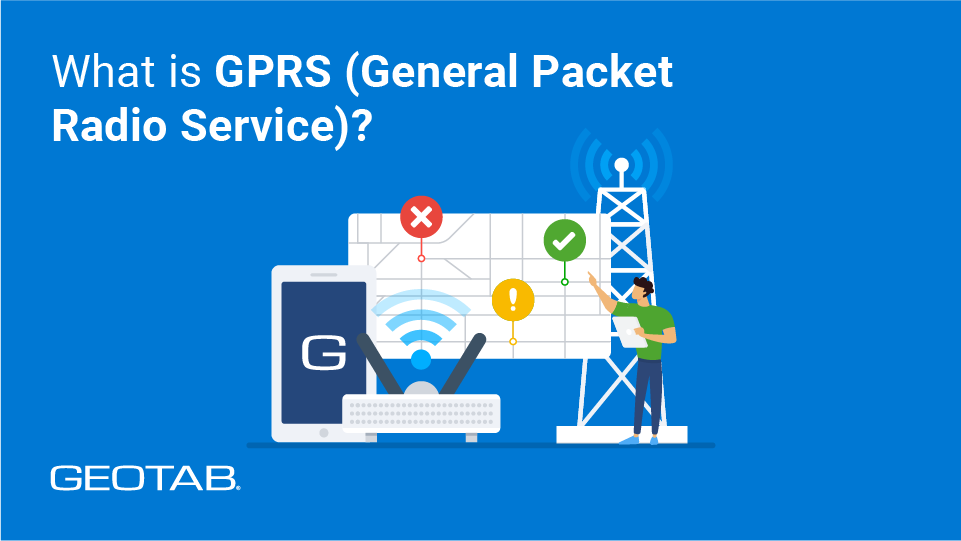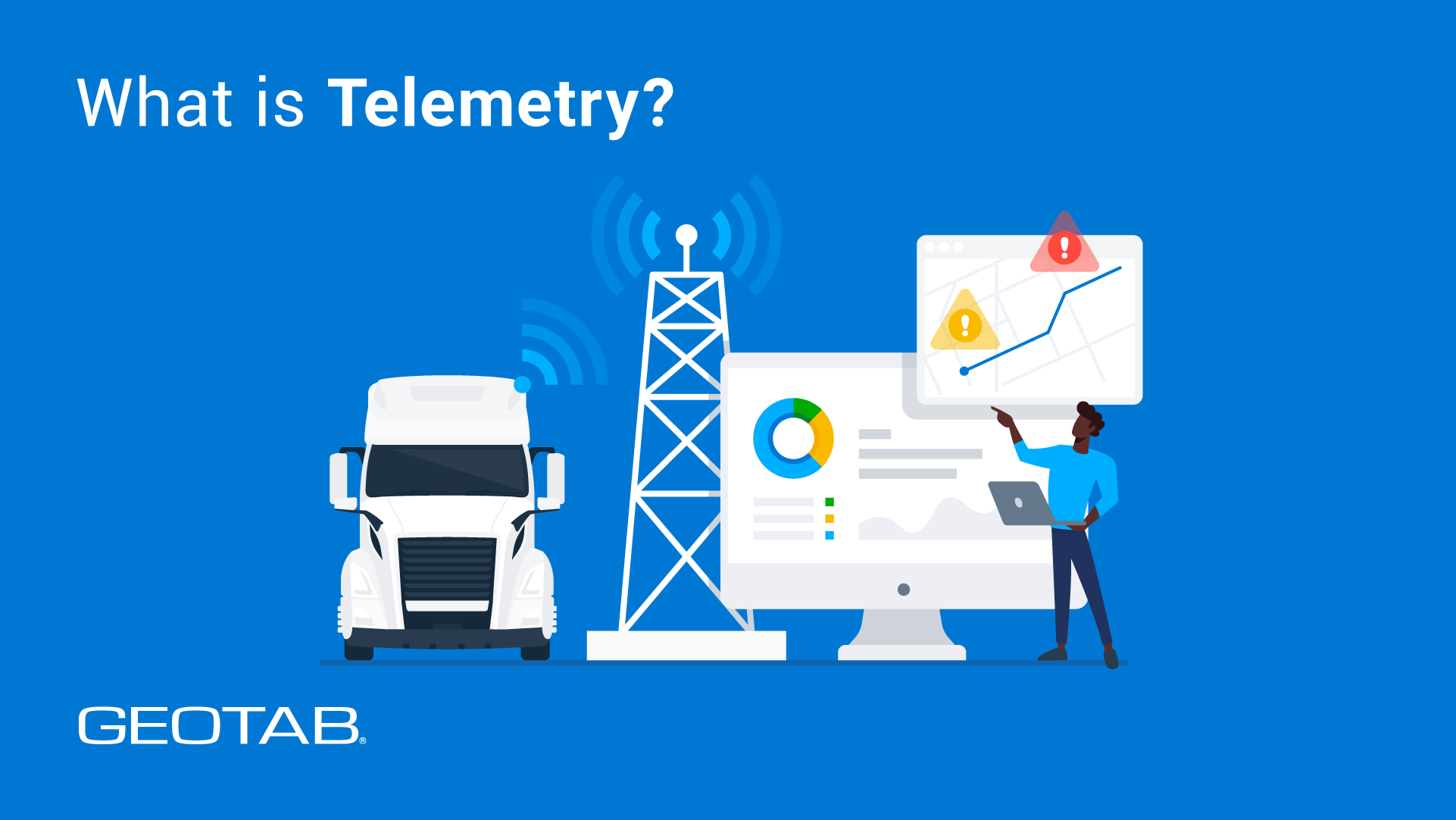What is GPRS?
August 8, 2025
•5 minute read

Definition
- GPRS stands for General Packet Radio Service, and it was the first mobile technology that allowed both voice and SMS communications between devices.
- GPRS is a transition between 2G and 3G mobile data technology, considered 2.5G.
What is GPRS?
GPRS is short for General Packet Radio Service (GPRS) and transmits data packets across wireless 2G and 3G cellular networks. GPRS allows owner-operators or dispatchers to improve real-time tracking, monitoring, and communication with their fleets of drivers. It improves fleet intelligence, allowing independent and commercial truckers to monitor fleet performance in real-time.
GPRS communicates accurate information about traffic conditions, under construction routes, weather conditions, and customer locations. This information helps optimize planned routes, reduce total travel times, conserve fuel, and optimize fleet management.
How does GPRS work?
GPRS overlays data using a packet-switched network on top of the existing Global System for Mobile Communications (GSM) circuit-switched infrastructure. While traditional GSM voice calls require dedicated channels, GPRS uses packet switching technology to segment individual pieces of data into smaller packets that are transmitted over available radio channels.
Drivers and dispatchers use individual data packets to securely communicate critical business matters, such as vehicle health assessments. Here are a few of the technical details about GPRS that will help you efficiently improve your fleet’s operations.
Packet switching to streamline data transmissions
Each data packet contains unique details, such as destination information for an upcoming order. By segmenting data into multiple packets, managers can use one radio channel to communicate sensitive information to all drivers. The packets keep each matter separate from another, saving time and lowering costs to transmit data across your fleet.
Time allocation per gross data rate
By organizing data into smaller packets, GPRS networks offer peak data rates of 115 kbps. Fleets can allocate time slots on the network for transmissions, based on network availability and the size of the data packets.
Consistent connectivity, real-time communication
Unlike dial-up connections that are spotty and prone to unexpected outages, GPRS maintains a persistent connection to a designated IP router. As a result, your fleet can maintain ongoing communications without losing time finding and establishing a connection for each data session.
Built-in support nodes for ongoing mobility
The Serving GPRS Support Node (SGSN) handles packet-switched data traffic, maintaining secure routing and mobility management. Additionally, the Gateway GPRS Support Node (GGSN) acts as the gateway connecting your GPRS network with localized internet connections.
Evolution from GSM to GPRS
Commercial service of GSM infrastructure first launched in 1991 throughout Europe. By 1994, over 1.3 million worldwide commercial subscribers were using GSM, growing to over 7.5 million in Europe alone by the end of 1995.
Gaining a foothold across Europe, the Middle East, Africa, and Asia, North America later developed a subsidiary of GSM infrastructure, known as PCS1900. By the early 2000’s, GSM and its subsidiaries were embedded globally.
When commercial fleets began using GSM, they were able to transfer summaries from voice calls between drivers and dispatchers. However, as fleets grew into more sophisticated businesses, operators realized GSM’s limited ability to effectively manage and transfer communications data. It was an ill-suited resource that required an upgrade.
GPRS was developed in the year 2000, and it officially launched with much fanfare in 2001. At the time, it was lauded as the technology that spearheaded rapid mobile internet consumption. It allowed businesses and consumers to securely share and transmit data in the form of email, web browsing, and other applications—a significant upgrade from voice-only transmissions.
GPRS was also considered a stepping stone, leading to the development of 3G wireless networks—later 4G and 5G. Developers also included a backward compatibility with GSM devices, ensuring those existing channels could be upgraded and integrated with the newer releases.
Key features of GPRS
These are the main features and benefits of GPRS:
- Enhanced data speed: Compared to GSM infrastructure, GPRS networks offer much higher and faster data transfer rates. Some studies report peak rates reaching up to 171 kbps, with an average around 115 kbps, using statistical multiplexing of over-the-air traffic. Fleets can establish packet-switched communication channels with greater efficiency, helping to improve safety, optimization, and fleet productivity.
- Efficient resource deployment: Eliminating the challenges of spotty wireless connectivity, GPRS’ continuous internet connectivity makes it easier to transmit packet-switched data across dedicated radio channels. Greater network capacity makes it faster and easier to share pertinent information across your fleet using a fully encrypted, secure network.
- Cost-effective usage and billing: Fleet managers can select pay-per-data-use models or time-based connections on GPRS networks. You can choose a plan that is best suited and most cost-effective for your fleet.
Applications of GPRS
Telematics is an essential management tool for most commercial fleets, using GPS technology and on-board diagnostics to track fleet vehicles. GPRS networks help fleets transmit telematics data that’s collected from sensors embedded in small vehicle tracking devices across the world.
Here are some of the most relevant GPRS applications to help gather, evaluate, and disseminate telematics data across your fleet.
Vehicle tracking
GPRS telematics applications allow fleet managers to monitor each vehicle’s real-time GPS location by tracking transmission data. The sensors use geo-fencing to plan and optimize routes that are dispatched to drivers in real-time. Drivers subsequently receive the most efficient route planning information, increasing their odds of completing all scheduled trips on time or ahead of schedule.
Risk management
Every driver is trusted to abide by safety protocols to protect themselves and reduce liability risks for the business. GPRS telematics transmit personal safety data to dispatchers, warning of any risks that could compromise personnel safety. Examples of risk management data include use of safety belts, speeding incidents, in-reverse driving, in-vehicle driver feedback, weather hazards, and anything that compromises driver safety.
Predictive maintenance
Every vehicle in a fleet must undergo periodic maintenance checks. Using GPRS telematics, fleet managers are transmitted data on fuel management, engine diagnostics, idling trends, digital keys, and fleet benchmarking to make necessary repairs before vehicles degrade towards a state of emergency.
Sustainability metrics
A current goal of fleet management is to make businesses more environmentally efficient and sustainable. GPRS networks can send packet-switched data about CO2 emissions and fuel consumption from gas-powered vehicles. Additionally, if your fleet has EV-powered vehicles, you can use GPRS to track EV battery degradation, EV performance monitoring metrics, and an electric vehicle sustainability assessment (EVSA) as part of a broader effort to electrify your broader fleet of vehicles.
Compliance data
Completing scheduled trips on time and with cargo intact is the top priority for fleet owners, but it’s important that drivers abide by regional laws and mandates during their trips. GPRS networks can process compliance metrics that legally protect the interests of the business, including vehicle inspection reports, electronic driver logs (EDLs), fuel tax reporting, and vehicle temperature monitoring. All these insights ensure vehicles are up to code, drivers respect the laws, and the business won’t be subject to non-compliance penalties.
Upgrades and expandability
Even the most sophisticated fleets can benefit from new technology to streamline operations, improve efficiencies, and help reduce operating expenses. Between API integrations, software add-ons, hardware upgrades, advanced analytics, and other technologies, you can use GPRS networks to communicate these opportunities across the fleet.
Communication without internet connectivity
Machine to machine (M2M) devices communicate across GPRS networks without the need for internet connectivity. Some fleet routes pass through truly remote destinations where internet connectivity is spotty, at best. Using the built-in M2M capabilities across GPRS networks, dispatchers can maintain real-time tracking of their drivers regardless of internet connectivity.
Challenges and limitations of GPRS
While GPRS offers many advantages for fleet management such as ”always-on” connectivity, support for various data packet communications, etc., there are also limitations to the value that GPRS can provide.
Performance limitations
GPRS networks are faster than traditional GSM communications, data speeds decrease as more users simultaneously transmit data packets across the network. The strength of the signal and congestion within the network can cause delays in how information is sent and received between communication devices. Latency in signal transmissions can impact GPRS applications, making it more challenging to optimize fleet management in real-time.
Security considerations
While GPRS networks include capable security measures that protect sensitive data, no system is foolproof. Some networks are vulnerable to cyber-hacking, spoofing, and tampering of data, all of which can leave fleets liable for non-compliance with data privacy protocols. For additional security, you can develop encrypted algorithms that scramble and unscramble data transmitted across GPRS networks, preventing bad actors from accessing your private data.
Obsolescence concerns
GPRS was initially developed to support 2G wireless network communications, serving as a stepping stone until 3G networks were created. Since then, 4G and 5G technologies have become ubiquitous within the market, offering superior performance. GPRS communications may be deeply embedded in your fleet management systems, but they have grown pricier to maintain and less relevant in the current market.
Frequently Asked Questions
GPRS stands for General Packet Radio Service, and it was the first mobile technology that allowed both voice and SMS communications between devices. GPRS is a transition between 2G and 3G mobile data technology, considered 2.5G, which gives you the ability to transmit data over a cellular communications network global system for mobile communications (GSM).
GPRS uses packet-switched networks to transmit sensitive data across cellular networks. It’s used for various applications like mobile web browsing, email, SMS, and other internet applications. GPRS gives fleet managers the ability to monitor vehicles in real-time, enabling fleets to make more accurate data-driven decisions to optimize fleet performance.
If your phone displays GPRS, it means your device is connected to 2G or 3G networks to transmit data about your fleet. GPRS helps drivers in remote locations continue to transmit data back to fleet dispatchers and managers when 4G or 5G networks are inaccessible. It allows businesses to continue optimizing fleet routes, monitoring predictive vehicular maintenance, and reduce risks to drivers in real-time.
Other Stories

What is telemetry? How it works and why fleets need it
December 24, 2025
4 minute read

What is a CAN Bus? How it impacts fleet management
December 1, 2025
6 minute read
July 17, 2025
4 minute read